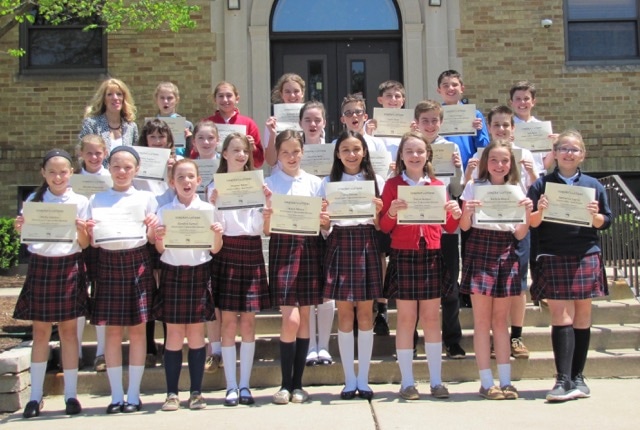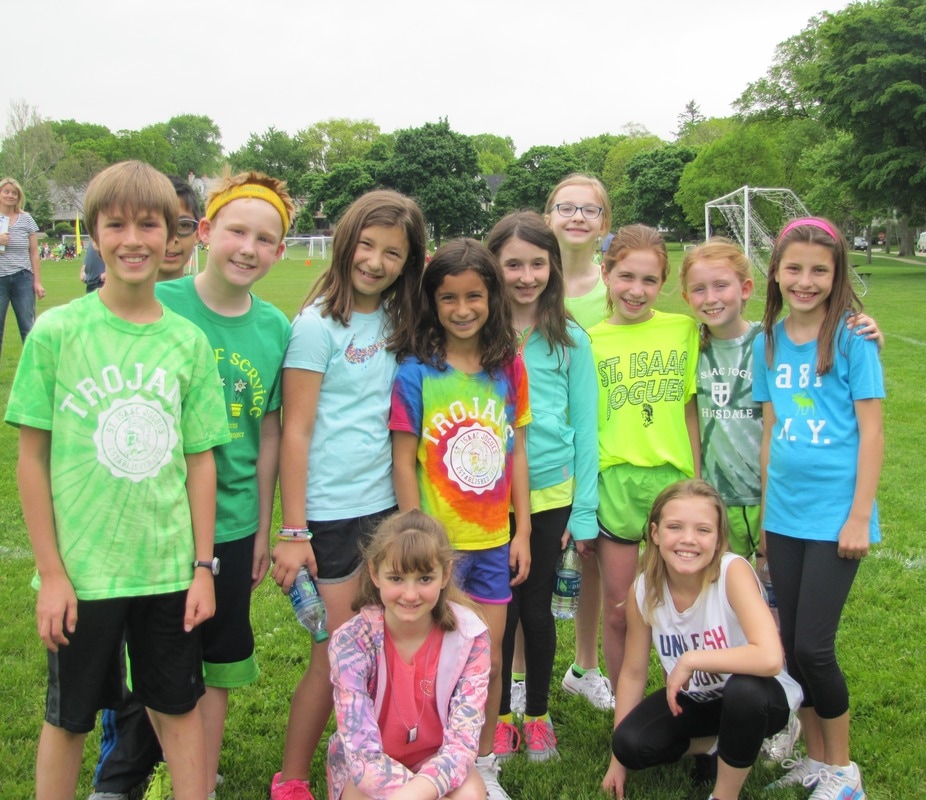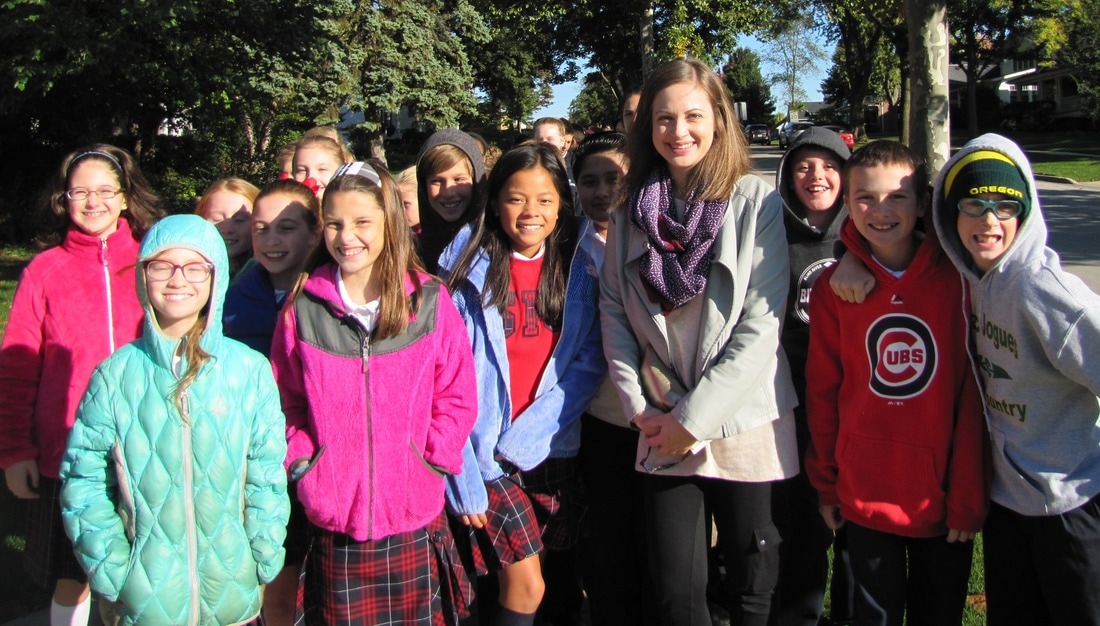5th Grade Curriculum
Religion
Students will learn about the Catholic faith through stories, activities, scripture, prayer, discussion and reflection. Values are integrated into all aspects of learning. Concepts include a study of:
- Worship of God as Catholic Christians;
- Baptism, Reconciliation, Eucharist, Confirmation;
- celebrating God’s healing love;
- Anointing of the Sick;
- special ways to holiness; Christian Marriage, Holy Orders;
- worship of God by living in love;
- seasons of Advent, Lent, Easter; and
- the Bible.
Language Arts
Our Language Arts program includes an integrated reading, writing, speaking, listening, study of grammar, and vocabulary. These subjects are taught over two consecutive class periods with the same instructor in an effort to build continuity throughout the grade and the building.
Reading
Students read and comprehends literary and informational texts independently while proficiently noting details, text structure, and integration of ideas. This includes short stories, 3 novel studies, poetry, informational print text and Newsela differentiated articles which focus on current events and cross-curricular topics.
Students research topics using print and digital tools to locate, analyze, and evaluate information. Students engage with research and analyze the author’s purpose, specific word choice and intended audience. Research always has a connection to the writing and speaking portion of the curriculum.
Classrooms have a focus to develop a lifelong love of reading through exposure to a wide variety of current & classic literature, nonfiction text, and self selected books.
Students attend an integrated weekly library class with ample opportunity to select books and magazines.
Students research topics using print and digital tools to locate, analyze, and evaluate information. Students engage with research and analyze the author’s purpose, specific word choice and intended audience. Research always has a connection to the writing and speaking portion of the curriculum.
Classrooms have a focus to develop a lifelong love of reading through exposure to a wide variety of current & classic literature, nonfiction text, and self selected books.
Students attend an integrated weekly library class with ample opportunity to select books and magazines.
Writing, Language, Speaking and Listening
Students learn how to produce clear and coherent writing in which the development, organization, and style are appropriate to task, purpose, and audience. Instruction in this area focuses on teacher led examples, face to face conferencing and the integration of electronic feedback loops to increase teacher/student collaborations.
Students will demonstrate a command of conventions of standard English grammar and usage when writing and speaking.
Students engage in a range of collaborative discussions building on listening to others’ ideas and clearly expressing their own.
Students acquire and use vocabulary based on grade level reading, content, and study of Latin and Greek roots.
Classrooms use a 1:1 digital tool initiative to produce and publish writing as appropriate.
Students will demonstrate a command of conventions of standard English grammar and usage when writing and speaking.
Students engage in a range of collaborative discussions building on listening to others’ ideas and clearly expressing their own.
Students acquire and use vocabulary based on grade level reading, content, and study of Latin and Greek roots.
Classrooms use a 1:1 digital tool initiative to produce and publish writing as appropriate.
Mathematics
Students will acquire a knowledge of mathematics and the ability to solve problems through the use of text, extended activities and hands-on experiences. Concepts include a study of:
- decimals and place value;
- estimation, addition and subtraction of whole numbers;
- collection of data and comparing;
- mean, median, mode and range;
- geometric figures, polygons and formulas;
- estimation and multiplication of two and three digit factors;
- estimation and division of two, three and four digits by one and two digits;
- estimation, multiplication and division of decimals;
- addition, subtraction, multiplication and division of fractions with like and unlike denominators;
- measurement, ratios, percents and probability; and
- analyzing problems using skill and strategies.
Social Studies
Students will study American history and geography from the first appearance of the Native Americans. Concepts include a study of:
- The Land and Early People;
- Native Americans;
- Age of Exploration;
- The Thirteen Colonies;
- The American Revolution;
- The Constitution;
- Exploring the West;
- The Civil War; and
- Geography: oceans, continents, landforms, rivers and lakes, North America and South America.
Science
Through the lense of Catholic teaching, students will use a variety of sources including hands-on experiences and 1:1 technology to understand science in the physical and natural world under the Next Generation Science Standards (NGSS). Students will also apply the Scientific Method through lab experiences and ongoing inquiry. Students will utilize the STEMScopes online resource as well as participate in weekly STEM pre-engineering lessons. In addition, students will incorporate critical thinking skills into reading informational texts. Concepts include a study of:
- energy movement through ecosystems;
- structure, properties, and changes in matter;
- forces, motion, and simple machines;
- Sun and other stars;
- Earth systems, water, and weather; and
- Earth and human activity
Spanish
Students will learn basic concepts of Spanish by reading, writing, listening and speaking. Concepts include a study of:
- learning basic conversational skills;
- use of numbers to tell age, phone number and dates;
- describing themselves and others;
- talking about likes and dislikes;
- differentiating between masculine and feminine words; and
- exploring Hispanic cultures.
Physical Education
Physical fitness and well being will continue to be encouraged by focusing on refining movement and manipulative skills that encourage a lifelong appreciation for a healthy life style. Concepts include:
- introduction to lead-up games and its rules, team sport skills are reinforced; and
- complex activities which require cooperative behavior are encouraged.
- ball and agility games;
- manipulative skills;
- fitnessgram;
- volleyball;
- long and short jump roping;
- basketball;
- soccer;
- Frisbee games; and
- team challenges.
Art
Students will be able to use all of the elements of design to create various art forms. Concepts include a study of:
- exploring the color principles at a more advanced level;
- introduced to cartography as an art form;
- being able to distinguish between abstract and realistic art;
- building upon their art vocabulary and ability to critiquing art work;
- drawing and painting in a variety of materials;
- patterning through string art;
- artists from around the world such as Vincent Van Gogh and Paul Klee; and
- using iPads.
Music
Students will learn and develop the concepts of:
- singing in groups;
- identifying instruments and musical styles through listening;
- singing, hearing and analyzing world music; and
- using iPads to practice rhythms.
Information Skills
Sixth graders evaluate various sources for information, using established standards for credibility and currency. Students interview local professionals to obtain information. Students continue to develop coding skills. Students read from the Caudill list, identifying personal preferences in author and genre. Students write Letters about Literature, developing and supporting thesis statements about their reading choices. Students will:
- understand the concept of plagiarism and cite sources properly;
- recognize point of view and opinion in various texts;
- understand scope and depth of different sources and utilize them appropriately for research;
- design and draw medals for the SIJ Book Award; and
- self-select books for checkout, developing preferences and stamina for reading independently.
Technology Skills
Students create and innovate via the use of educational Apps in a 1:1 iPad to student environment.
Using the Google Suite for Education (GSFE), students create documents, spreadsheets and presentations. They are introduced to Google add-ons which allow students to incorporate graphics and other multimedia tools into their documents.
Students learn to collaborate through GSFE. This technology in our 1:1 environment teaches students group dynamics, encourages leadership and personal accountability.
Online resources are used to support the research projects across all content areas. This includes World Book, Britannica School, Novelist, and Infoplease.
Critical thinking and problem solving are supported via the use of STEMscopes and the STEM lab which meets once a week.
Digital Citizenship includes lessons from Common Sense Media. These lessons focus on internet safety, cyberbullying & creating a positive digital footprint.
Using the Google Suite for Education (GSFE), students create documents, spreadsheets and presentations. They are introduced to Google add-ons which allow students to incorporate graphics and other multimedia tools into their documents.
Students learn to collaborate through GSFE. This technology in our 1:1 environment teaches students group dynamics, encourages leadership and personal accountability.
Online resources are used to support the research projects across all content areas. This includes World Book, Britannica School, Novelist, and Infoplease.
Critical thinking and problem solving are supported via the use of STEMscopes and the STEM lab which meets once a week.
Digital Citizenship includes lessons from Common Sense Media. These lessons focus on internet safety, cyberbullying & creating a positive digital footprint.
STEM
The Project Lead The Way Launch Interdisciplinary Curriculum is designed for fifth grade students to become problem solvers. Students use structured approaches, like the engineering design process, through compelling activities, projects, and problems that build upon each other and relate to the world around them. They apply STEM knowledge, emphasize creativity, skills, and habits of mind, and discover that trying different approaches and solutions is an essential part of the learning process. Students apply newly acquired knowledge and skills as they collaborate and utilize the design process to define the problem, sketch, build using available materials, test, and reflect on their designs. Student learning is centered on strong literacy and communication skills while building students’ understanding of challenging content in the areas of mathematics, science, technology, and engineering.
Elements and skills of our Project Lead The Way Launch curriculum for Fifth Grade include:
Elements and skills of our Project Lead The Way Launch curriculum for Fifth Grade include:
- The PLTW Fifth Grade Curriculum includes four modules that bring learning to life: Infection: Detection, Infection: Modeling and Simulation, Robotics and Automation, and Robotics and Automation: Challenge;
- The PLTW Curriculum is aligned with the Next Generation Learning Goals and Standards for Fifth Grade;
- leadership skills;
- inquiry- rich content that links reading, communication and science in every activity;
- problem-based-, project-based, and inquiry-based learning and team collaborative decision-making;
- academic concepts are coupled with real world problems;
- students’ exploration of robotics includes ways robots are used in today’s world and impact of their use in society;
- learn about a variety of robotic components as they build, test, and remotely control mobile robots;
- discover powerful ideas about computing as they investigate models and simulations;
- Engineering notebook organization and documentation;
- model with mathematics;
- reason abstractly and quantitatively;
- use appropriate tools strategically;
- learning is measured through PLTW rubrics and assessments which use performance-based formative assessments and summative, content based specific assessments;
- STEM lab;
- PLTW online curriculum; and
- extensive use of technology: 1:1 iPads.
Resource and Speech/Language Pathology
St. Isaac Jogues School provides on site speech/language and resource services. Curriculum is child specific and designed to meet needs in reading, math and communication skills.





